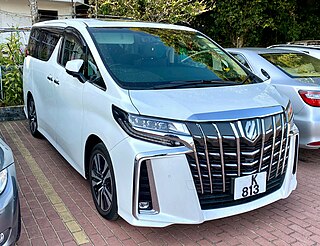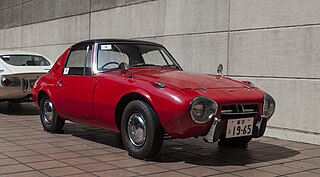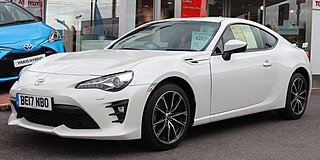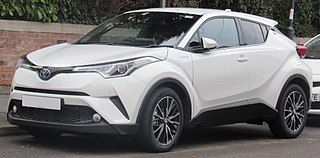
The Toyota RAV4 is a compact crossover SUV produced by the Japanese automobile manufacturer Toyota. Considered the first ever compact crossover SUV, it made its debut in Japan and Europe in 1994, and in North America in 1995, being launched in January 1996. The vehicle was designed for consumers wanting a vehicle that had most of the benefits of SUVs, such as increased cargo room, higher visibility, and the option of full-time four-wheel drive, along with the manoeuvrability and fuel economy of a compact car. The vehicle's name is an abbreviation of "Recreational Active Vehicle with 4-wheel drive", or "Robust Accurate Vehicle with 4-wheel drive", although not all models come equipped with the four-wheel drive system.

The Toyota Crown is an automobile which has been produced by Toyota in Japan since 1955. It is primarily a line of mid-size luxury cars that is marketed as an upmarket offering in the Toyota lineup.

The Toyota Alphard is a minivan produced by the Japanese automaker Toyota since 2002. It is available as a seven or eight-seater with petrol and hybrid engine options. Hybrid variants have been available since 2003, which incorporates Toyota's Hybrid Synergy Drive technology. It is Toyota's flagship minivan.

The Toyota Noah is a minivan with two rear sliding doors built by Toyota and sold mainly in Asian countries. It is positioned below the Alphard, and above the Sienta. The Noah was also positioned below the Estima until the latter was discontinued in 2019.

The Toyota HiAce is a light commercial vehicle produced by the Japanese automobile manufacturer Toyota. First launched in October 1967, the HiAce has since been available in a wide range of body configurations, including a minivan/MPV, minibus, panel van, crew van, pickup truck, taxi and an ambulance. In Japan, the HiAce is exclusive to Toyopet Store locations.

The Toyota Sports 800 is Toyota's first production sports car. The prototype for the Sports 800, called the Publica Sports, debuted at the 1962 Tokyo Auto Show, featuring a space age sliding canopy and utilizing the 21 kW powertrain of the Publica 700, a Japanese market economy car. The Toyota Sports 800 is affectionately called the "Yota-Hachi" (ヨタハチ), which is a Japanese short form for "Toyota 8". In Japan, the vehicle was exclusive to Toyota Japan retail sales channel called Toyota Publica Store alongside the Publica.

The Nissan Sakura is a battery electric kei car marketed by Nissan and produced by NMKV. Named after the national flower of Japan, it was introduced on 20 May 2022 as the first battery electric kei car from Nissan. It is developed and manufactured alongside the Mitsubishi eK X EV, which shares the same body with the petrol-powered eK X. Its design was previewed by the IMk concept which was showcased in 2019.
This is a list of concept vehicles from Toyota for the years 2010–2019.

The Toyota 86 and the Subaru BRZ are 2+2 sports cars jointly developed by Toyota and Subaru, manufactured at Subaru's Gunma assembly plant.

The Toyota MiniAce was a small utility vehicle built by Toyota from November 1967 until November 1975. It shared many parts with the Toyota Publica, especially the Publica P20 Pickup. In Japan, it was sold through the Toyota Corolla Store and Toyota Auto Store networks. Because it shares many parts with the popular Toyota Publica and the highly collectable Toyota Sports 800 most MiniAces have been used for parts and very few survive. Its exterior dimensions and engine displacement, while very small, do not conform to "kei car" Japanese government regulations.
Toyota Motor East Japan is a manufacturing subsidiary of the Toyota group based in Japan. It was founded in July 2012 by the merger of Central Motors, Kanto Auto Works and Toyota Motors Tohoku.

The Toyota C-HR is a subcompact crossover SUV manufactured by Japanese automaker Toyota since 2016. The development of the car began in 2013, led by Toyota chief engineer Hiroyuki Koba. The C-HR is based on the same TNGA-C (GA-C) platform as the E210 series Corolla, and positioned between the Corolla Cross and Yaris Cross in size.

The Suzuki Baleno is a subcompact car produced by the Japanese manufacturer Suzuki in India since September 2015 with a hatchback body style.

Toyota Auto Body is a manufacturing subsidiary of the Toyota group based in Japan. It is headquartered in Kariya, Aichi and was established in 1945. The company has plants in the Mie and Aichi prefectures and other facilities around Japan and abroad.

The XP210 series Toyota Yaris is the fourth generation of the Yaris, a subcompact car/supermini (B-segment) manufactured by Toyota for the Japanese, European and Australasian markets. The model was released in October 2019 to replace the XP130 series Yaris/Vitz, and built on the GA-B platform. Unlike the preceding Vitz-based Yaris models, the standard XP210 series Yaris variants are only available in 5-door hatchback bodywork; the bespoke 3-door model is reserved for the performance-oriented variant called GR Yaris.
The Daihatsu New Global Architecture (abbreviated as DNGA) is a modular unibody automobile platform that underpin various Daihatsu vehicles and its rebadged versions supplied for Toyota, Subaru, and Perodua. Introduced in 2019, it is aimed for vehicles built for the Japanese market and overseas emerging markets. Daihatsu has planned to introduce the platform to 21 models and 15 body types with a targeted annual production of 2.5 million vehicles to be sold in 90 countries by 2025. Despite the similar naming, it is not mechanically related to the Toyota New Global Architecture.

The Toyota C+pod (stylised as C+pod) is a two-seat battery electric kei car manufactured by the Japanese automaker Toyota. Its design was previewed by the Ultra-Compact BEV concept car from October 2019, and its production form was revealed on 25 December 2020. The first batch was sold limited to corporate users, local governments and other organisations in Japan. It is later sold to individual customers starting in December 2021.

The Mazda2 is a subcompact/supermini (B-segment) car manufactured and marketed by Mazda since 2002, currently in its third generation. An entry-level model of the brand in markets outside Japan, the Mazda2 is positioned below the Mazda3. The Mazda2 has also been marketed as the Mazda Demio, while its direct predecessor was exported as the Mazda 121.
Toyota Motor Kyushu (TMK) is a manufacturing subsidiary of Toyota established in 1991 and focused on the production of Lexus cars, engines, and hybrid systems. Its headquarters and single assembly plant are in Miyawaka, Fukuoka. Car production started in December 1992.

The Toyota bZ4X, also marketed in Japan, US, Canada, Europe, and China as the Subaru Solterra, is a battery electric compact crossover SUV manufactured by Toyota. The vehicle debuted in April 2021 as the "bZ4X Concept". It is the first vehicle to be based on the e-TNGA platform co-developed by Toyota and Subaru, and the brand's first model to be part of their Toyota bZ series of zero-emissions vehicles.

















